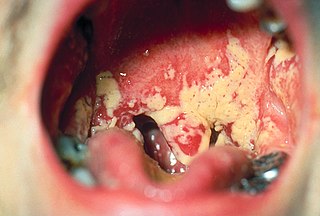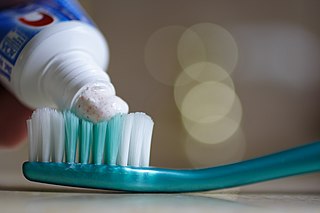Related Research Articles

Human teeth function to mechanically break down items of food by cutting and crushing them in preparation for swallowing and digesting. As such, they are considered part of the human digestive system. Humans have four types of teeth: incisors, canines, premolars, and molars, which each have a specific function. The incisors cut the food, the canines tear the food and the molars and premolars crush the food. The roots of teeth are embedded in the maxilla or the mandible and are covered by gums. Teeth are made of multiple tissues of varying density and hardness.

The salivary glands in many vertebrates including mammals are exocrine glands that produce saliva through a system of ducts. Humans have three paired major salivary glands, as well as hundreds of minor salivary glands. Salivary glands can be classified as serous, mucous, or seromucous (mixed).

Xylitol is a chemical compound with the formula C
5H
12O
5, or HO(CH2)(CHOH)3(CH2)OH; specifically, one particular stereoisomer with that structural formula. It is a colorless or white crystalline solid that is freely soluble in water. It can be classified as a polyalcohol and a sugar alcohol, specifically an alditol. The name derives from Ancient Greek: ξύλον, xyl[on] 'wood', with the suffix -itol used to denote sugar alcohols.

Tooth enamel is one of the four major tissues that make up the tooth in humans and many animals, including some species of fish. It makes up the normally visible part of the tooth, covering the crown. The other major tissues are dentin, cementum, and dental pulp. It is a very hard, white to off-white, highly mineralised substance that acts as a barrier to protect the tooth but can become susceptible to degradation, especially by acids from food and drink. Calcium hardens the tooth enamel. In rare circumstances enamel fails to form, leaving the underlying dentin exposed on the surface.

Tooth decay, also known as cavities or caries, is the breakdown of teeth due to acids produced by bacteria. The cavities may be a number of different colors from yellow to black. Symptoms may include pain and difficulty with eating. Complications may include inflammation of the tissue around the tooth, tooth loss and infection or abscess formation.

Streptococcus mutans is a facultatively anaerobic, gram-positive coccus commonly found in the human oral cavity and is a significant contributor to tooth decay. It is part of the "streptococci", an informal general name for all species in the genus Streptococcus. The microbe was first described by James Kilian Clarke in 1924.
Dental plaque is a biofilm of microorganisms that grows on surfaces within the mouth. It is a sticky colorless deposit at first, but when it forms tartar, it is often brown or pale yellow. It is commonly found between the teeth, on the front of teeth, behind teeth, on chewing surfaces, along the gumline (supragingival), or below the gumline cervical margins (subgingival). Dental plaque is also known as microbial plaque, oral biofilm, dental biofilm, dental plaque biofilm or bacterial plaque biofilm. Bacterial plaque is one of the major causes for dental decay and gum disease.

Early childhood caries (ECC), formerly known as nursing bottle caries, baby bottle tooth decay, night bottle mouth and night bottle caries, is a disease that affects teeth in children aged between birth and 71 months. ECC is characterized by the presence of 1 or more decayed, missing, or filled tooth surfaces in any primary tooth. ECC has been shown to be a very common, transmissible bacterial infection, usually passed from the primary caregiver to the child. The main bacteria responsible for dental caries are Streptococcus mutans and Lactobacillus. There is also evidence that supports that those who are in lower socioeconomic populations are at greater risk of developing ECC.
A caries vaccine is a vaccine to prevent and protect against tooth decay. Streptococcus mutans has been identified as the major etiological agent of human dental caries. The development of a vaccine for tooth decay has been under investigation since the 1970s. In 1972, a caries vaccine was said to be in animal testing in England, and that it would have begun human testing soon. However, intrinsic difficulties in developing it, coupled with lack of strong economic interests, are the reasons why still no such vaccine is commercially available today. Several types of vaccines are being developed at research centres, with some kind of caries vaccines being considered to diminish or prevent dental caries' impact on young people.

Oral microbiology is the study of the microorganisms (microbiota) of the oral cavity and their interactions between oral microorganisms or with the host. The environment present in the human mouth is suited to the growth of characteristic microorganisms found there. It provides a source of water and nutrients, as well as a moderate temperature. Resident microbes of the mouth adhere to the teeth and gums to resist mechanical flushing from the mouth to stomach where acid-sensitive microbes are destroyed by hydrochloric acid.

Oral hygiene is the practice of keeping one's oral cavity clean and free of disease and other problems by regular brushing of the teeth and adopting good hygiene habits. It is important that oral hygiene be carried out on a regular basis to enable prevention of dental disease and bad breath. The most common types of dental disease are tooth decay and gum diseases, including gingivitis, and periodontitis.

Tooth remineralization is the natural repair process for non-cavitated tooth lesions, in which calcium, phosphate and sometimes fluoride ions are deposited into crystal voids in demineralised enamel. Remineralization can contribute towards restoring strength and function within tooth structure.

Willoughby Dayton Miller (1853–1907) was an American dentist and the first oral microbiologist.

Oral ecology is the microbial ecology of the microorganisms found in mouths. Oral ecology, like all forms of ecology, involves the study of the living things found in oral cavities as well as their interactions with each other and with their environment. Oral ecology is frequently investigated from the perspective of oral disease prevention, often focusing on conditions such as dental caries, candidiasis ("thrush"), gingivitis, periodontal disease, and others. However, many of the interactions between the microbiota and oral environment protect from disease and support a healthy oral cavity. Interactions between microbes and their environment can result in the stabilization or destabilization of the oral microbiome, with destabilization believed to result in disease states. Destabilization of the microbiome can be influenced by several factors, including diet changes, drugs or immune system disorders.
Streptococcus sobrinus is a Gram-positive, catalase-negative, non-motile, and anaerobic member of the genus Streptococcus.
Biotene is an over-the-counter dental hygiene product currently marketed by GlaxoSmithKline (GSK). It comes in a number of forms, including toothpaste, mouthwash and gel.

Lactoperoxidase is a peroxidase enzyme secreted from mammary, salivary and other mucosal glands including the lungs, bronchii and nose that functions as a natural and the first line of defense against bacteria and viruses. Lactoperoxidase is a member of the heme peroxidase family of enzymes. In humans, lactoperoxidase is encoded by the LPO gene.

Glucansucrase is an enzyme in the glycoside hydrolase family GH70 used by lactic acid bacteria to split sucrose and use resulting glucose molecules to build long, sticky biofilm chains. These extracellular homopolysaccharides are called α-glucan polymers.
Oral disease is one of the most common diseases found in dogs. It is caused by the buildup of various anaerobic bacteria in the mouth which forms plaque, eventually hardening into tartar on the teeth along the gum line, and is related to the development of gingivitis. Since small and toy breeds have a much smaller jaw but contain the same number of teeth, crowding allows higher bacterial build up and puts them at higher risk of developing periodontal disease.
Topical fluorides are fluoride-containing drugs indicated in prevention and treatment of dental caries, particularly in children's primary dentitions. The dental-protecting property of topical fluoride can be attributed to multiple mechanisms of action, including the promotion of remineralization of decalcified enamel, the inhibition of the cariogenic microbial metabolism in dental plaque and the increase of tooth resistance to acid dissolution. Topical fluoride is available in a variety of dose forms, for example, toothpaste, mouth rinses, varnish and silver diamine solution. These dosage forms possess different absorption mechanisms and consist of different active ingredients. Common active ingredients include sodium fluoride, stannous fluoride, silver diamine fluoride. These ingredients account for different pharmacokinetic profiles, thereby having varied dosing regimes and therapeutic effects. A minority of individuals may experience certain adverse effects, including dermatological irritation, hypersensitivity reactions, neurotoxicity and dental fluorosis. In severe cases, fluoride overdose may lead to acute toxicity. While topical fluoride is effective in preventing dental caries, it should be used with caution in specific situations to avoid undesired side effects.
References
- 1 2 Newman, Michael G. Carranza's Clinical Periodontology, 10th Edition. Saunders Book Company, 072006. 9.4.2.
- ↑ Hannig, Christian; Becker, Klaus; Häusler, Nico; Hoth-Hannig, Wiebke; Attin, Thomas; Hannig, Matthias (2007-05-01). "Protective effect of the in situ pellicle on dentin erosion - an ex vivo pilot study". Archives of Oral Biology. 52 (5): 444–449. doi:10.1016/j.archoralbio.2006.10.015. ISSN 0003-9969. PMID 17126806.
- ↑ Hara, A. T.; Ando, M.; González-Cabezas, C.; Cury, J. A.; Serra, M. C.; Zero, D. T. (2006-07-01). "Protective effect of the dental pellicle against erosive challenges in situ". Journal of Dental Research. 85 (7): 612–616. doi:10.1177/154405910608500706. ISSN 0022-0345. PMID 16798860.
- ↑ Samaranayake, Lakshman. Essential Microbiology for Dentistry, 3rd Edition. Churchill Livingstone, 092006.
- 1 2 Roberson, Theodore. Sturdevant's Art and Science of Operative Dentistry, 5th Edition. C.V. Mosby, 042006. 3.2.2.
- ↑ Harris, Norman O. Primary Preventive Dentistry, 6th Edition. Prentice Hall, 082003. 2.4).
- ↑ Miller, Chris H. Infection Control and Management of Hazardous Materials for the Dental Team, 3rd Edition. Mosby, 092004. 2.3.3.3).